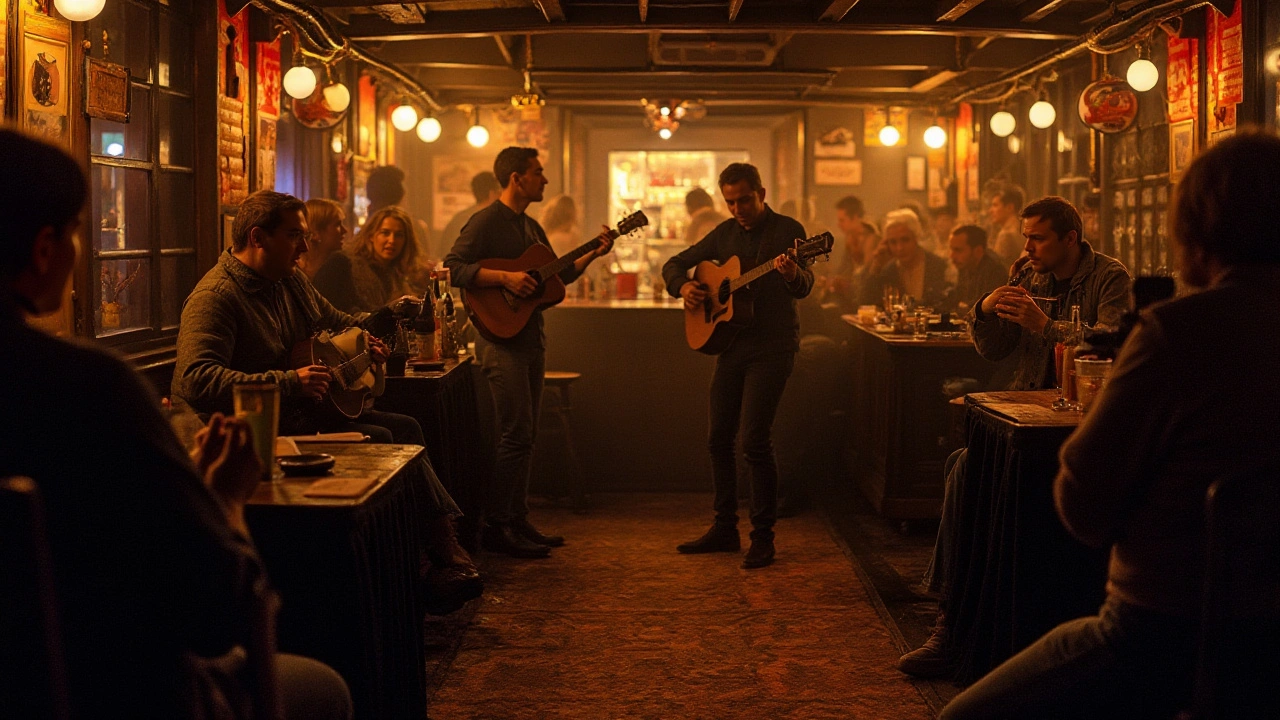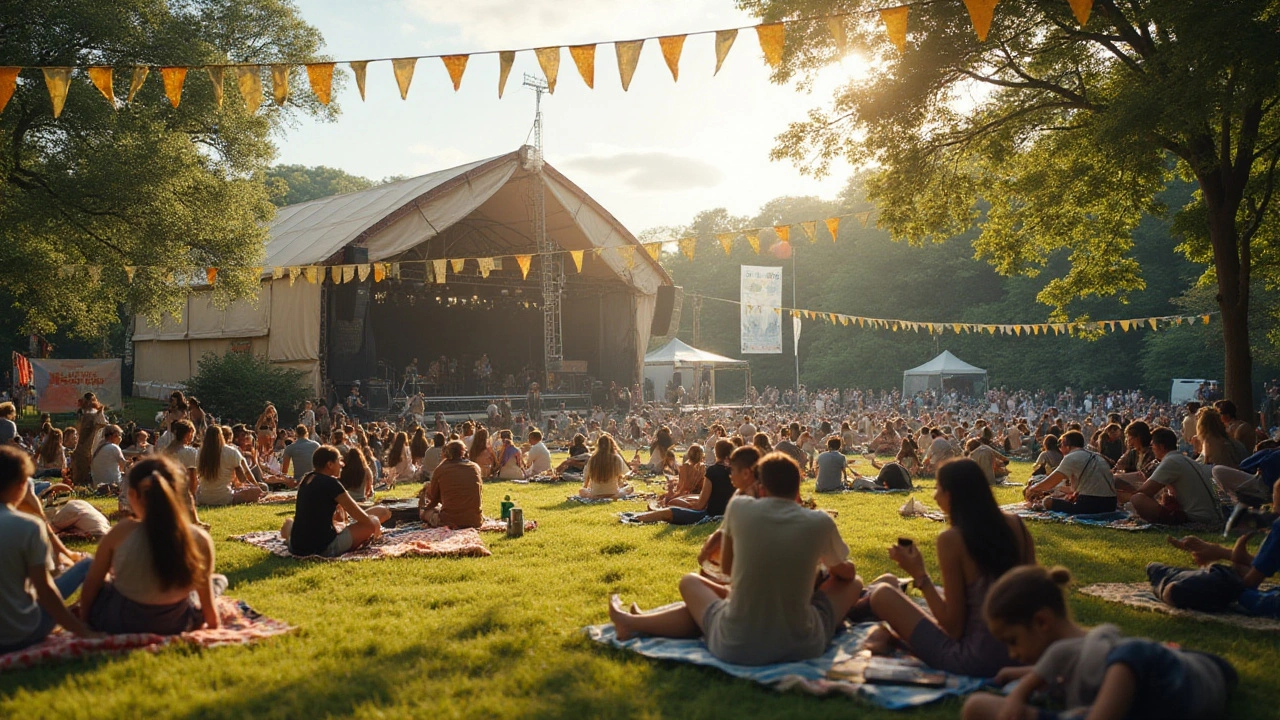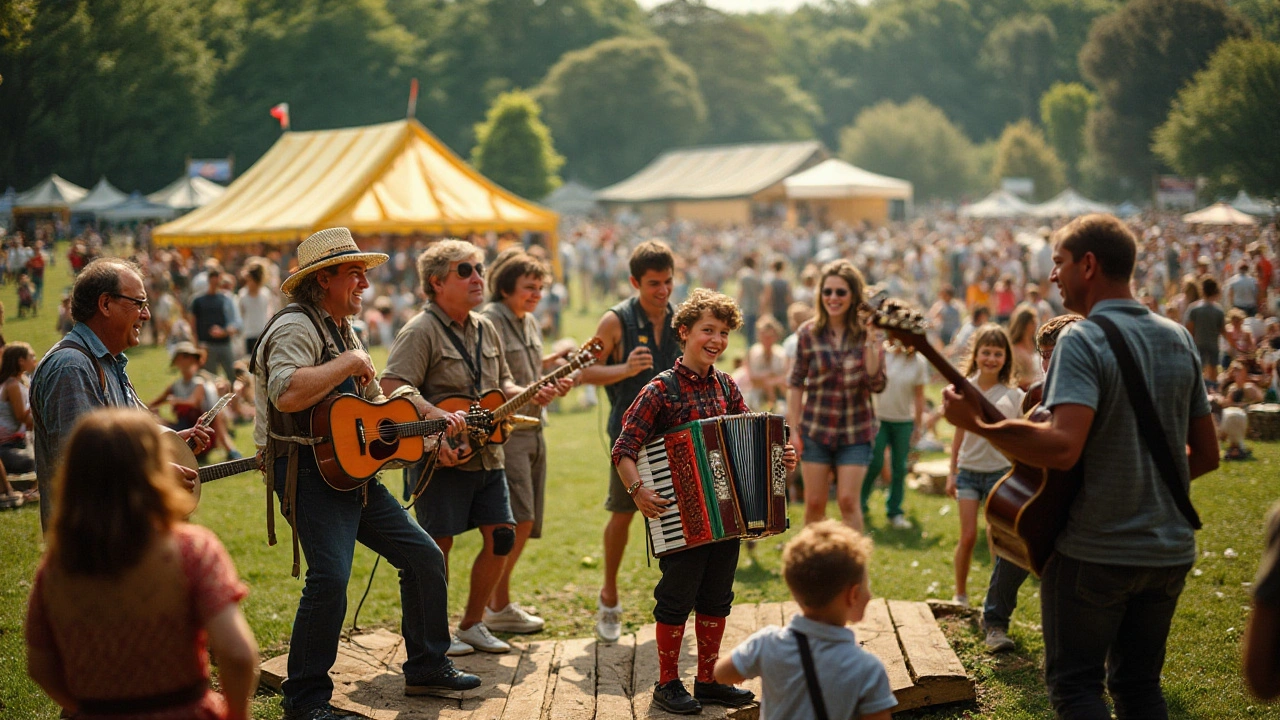Folk music has always been more than just a genre; it's a reflection of cultural history and community spirit. For centuries, it has been the medium through which stories, traditions, and values have been passed down from generation to generation. However, with the advent of modern music forms, folk music witnessed a steady decline. Now, a spirited revival is breathing new life into this treasured art form.
The digital age, surprisingly, has played a pivotal role in bringing folk music back into the spotlight. Artists are weaving contemporary elements into timeless melodies, creating a sound that resonates across age groups. This fusion has fueled a renewed interest, drawing young listeners eager to explore the deep roots of their cultural heritage.
In various communities around the world, efforts are underway to preserve and celebrate the unique aspects of folk music. Innovative artists are committed to keeping these traditions alive, taking to stages from local pubs to massive festivals. Through their passion and dedication, folk festivals serve as a vibrant meeting place where people from all walks of life connect through the universal language of music.
- The Origins and Evolution of Folk Music
- The Role of Technology in the Revival
- Cultural Significance and Preservation
- Modern Artists Embracing Folk Traditions
- The Role of Festivals in Promoting Folk Music
The Origins and Evolution of Folk Music
Folk music, often regarded as the heart and soul of cultural expression, traces its roots deep into antiquity. This musical form emerged from communities where songs were a cornerstone of everyday life. Whether telling tales of historical events, celebrating the harvest, or lamenting lost love, folk music captured the true essence of human experience. Its origins can be seen in the nomadic tribes of Africa, the ancient ballads of Europe, and the indigenous chants of the Americas. Each region contributed its own unique sound, fostering a rich tapestry of melodies and rhythms that reflected their surroundings and stories.
As societies evolved, so did their music. Folk traditions were passed down orally, ensuring they remained fluid and adaptable. This adaptability allowed folk music to survive centuries of change. With every new generation, subtle additions and influences from other cultures enriched the existing repertoire. For example, the incorporation of African rhythms into American folk music gave rise to genres like blues and jazz. These influences exemplify folk music's remarkable capacity to evolve while retaining its core identity. Over time, instruments such as the guitar, banjo, and fiddle became synonymous with folk music, each adding distinct character to the genre.
The advent of the Industrial Revolution and related urbanization presented both challenges and opportunities. As people flocked to cities in search of work, the geographical spread of folk music expanded, allowing regional styles to intermingle. This led to the creation of new forms of folk expression. The period also saw the emergence of folk music collectors who realized the cultural importance of preserving traditional songs. Figures like Cecil Sharp in England and John Lomax in America made it their mission to document these songs, safeguarding a treasure trove of cultural heritage for future generations. Their efforts highlighted the significance of folk music as a vital link to the past.
The 20th century ushered in a remarkable revival of folk music, largely driven by social and political movements. Artists like Woody Guthrie and Pete Seeger utilized folk music to address contemporary issues, turning their songs into powerful tools for change. During the 1960s, the folk revival movement gained momentum, with music serving as a catalyst for social transformation. This period also heralded the arrival of iconic figures such as Bob Dylan and Joan Baez, who used folk music's timeless simplicity to articulate complex political and social messages. Their contributions ensured that folk music maintained relevance, bridging generations and ideas.
In recent years, the digital age has breathed new life into folk music, allowing artists to blend tradition with modern influence seamlessly. Platforms like Spotify and YouTube have made folk music accessible to a global audience, rekindling interest and appreciation. Musicians are exploring innovative ways to incorporate electronic elements alongside traditional sounds, creating a vibrant, evolving genre that speaks to old and new listeners alike. Projects that promote cultural exchange, collaboration, and inclusivity further underscore the enduring appeal of folk music. As we stand at the crossroads of tradition and modernity, it's clear that folk music continues to evolve while staying rooted in its origins.
The Role of Technology in the Revival
The resurgence of folk music in recent years owes much to the innovations of the digital age. For decades, traditional tunes were relegated to dusty old records and fading memories. However, the advent of the internet, streaming services, and social media platforms has democratized music in unprecedented ways, opening doors that were previously shut to countless musicians around the globe. In particular, platforms like Spotify and Apple Music have enabled folk artists to reach audiences far beyond their local communities, introducing their art to listeners on a worldwide stage.
The use of technology has not only expanded reach but has also redefined what it means to be a folk musician today. Many artists are now experimenting with fusion, blending their traditional sounds with contemporary influences to create a unique musical experience. This blend has made the genre more relatable to younger audiences who crave both connection to their roots and new, fresh sounds. The possibilities technology provides for recording and producing music at home have also resulted in a boom of indie folk artists who bypass traditional production barriers. As a result, we're seeing a vibrant array of sounds and styles emerge, each contributing uniquely to the folk genre renaissance.
Social media plays a critical role in fostering communities and discussions around folk music as well. Platforms like Instagram and YouTube have witnessed a surge in folk enthusiasm, as they allow artists to share and promote their work directly, offering behind-the-scenes glimpses into the creative process. These platforms provide interactive spaces for fans to engage with music in new ways, through live streams, Q&A sessions, and collaborations that transcend geographical barriers. This has created a sense of community and intimacy that resonates deeply with people who have a passion for tradition and storytelling.
One folk musician explained in an interview with Rolling Stone, "Technology hasn't just given folk music a lifeline; it has underscored its relevance today. We've been able to adapt and share our cultural heritage in ways our ancestors would never have imagined."This insight underlines how the confluence of traditional art forms and modern tech continues to redefine the boundaries of folk music. The digital age has breathed new life into folk music festivals too, with live event streaming allowing those who cannot attend in person to experience the atmosphere virtually, reaching a global audience and piquing interest among diverse listeners.
In addition to spreading awareness, digital platforms also serve as vast archives of folk music. Collectors and enthusiasts preserve rare recordings and share them online, ensuring that valuable cultural artifacts are not lost to time. Moreover, in the world of folk music, where oral traditions are paramount, technology is a tool that keeps these stories alive. Websites dedicated to preserving folk lyrics, history, and instruments offer educational resources and foster a celebration of this rich cultural tapestry. The we're seeing in folk music today is not just a revival of sound but a revival of cultural identity, technology playing an instrumental role in each note.
By leveraging technology, folk musicians are empowered to shape their own narratives, guiding the genre toward a bright future. In this new era, the increase in access to folk music, paired with a rising appreciation for cultural heritage, suggests that it's not merely surviving, but rather thriving—approached more as living breathing history, continuously written and performed every day.

Cultural Significance and Preservation
The cultural baggage that folk music carries is immense. It's a soundtrack to history, echoing the triumphs and struggles of the people who came before us. These melodies have walked with our ancestors, narrating tales of bravery, love, hardship, and celebration. Each note is not just a sound but a piece of the identity of a community. Preserving these tunes is akin to preserving the very soul of a culture, and it is an endeavor ardently pursued by historians, musicians, and enthusiasts alike. This genre serves as a repository of the collective human experience, providing relevance and context to the lives we lead today.
What often makes folk music so important is its grassroots nature. Unlike many commercial music genres, folk music originates from the people, by the people. Its roots dive deep into the soil of society, nourished by the stories that make it grow. The songs reflect the actual experiences of life, from the pains of labor to the joys of festivities, painting vivid images of everyday life in its most unadulterated form. These compositions are often passed down orally, cherished across generations, each storyteller adding a little part of themselves to the tale. Such deep connections are why the preservation efforts gain their fervor—this music is not just about entertainment but about keeping alive a living, breathing canvass of human society.
In recent years, there has been a conscious initiative to archive and document this invaluable heritage. From digital recording projects to establishing community archives, multiple approaches are being taken to safeguard these fragile memories. The technology aids in this digitization, allowing sprawling libraries like Smithsonian Folkways to offer a vast repository of archived songs. This medium preserves sound, words, and even the emotions once captured only in real-time gatherings around campfires and village squares.
Initiatives like The Alan Lomax Archive, the brainchild of one of the world's most famous ethnomusicologists, are central to this preservation mission. His work spanned decades of field recordings, capturing everything from American blues and cakewalks to British folk ballads, all integral to the cultural fabric he and so many of his peers have fought hard to preserve.
"The value of folk music lies in a shared heritage that tells the story of the human condition," Lomax once mentioned, emphasizing the critical nature of holding onto our most personable stories.In this era of globalization, folk music remains a vital and definitive link to our ancestors, connecting us to a more grounded understanding of humanity's vast and varied experiences.
Efforts to preserve folk music go beyond documentation. They're infused in educational programs and community gatherings where enthusiasts and newcomers alike can learn about crafting instruments, singing songs, and absorbing the historical context that breathes life into these old tales. Festivals also play an incredibly important role, emerging as spaces where live performances bring the past to life. These gatherings ensure that folk music does not just survive as an archived relic but thrives as an evolving tradition actively engaging newer generations.
Moreover, there is an increasing interest in collaborations with local musicians and international artists. This ensures that folk songs not only keep surviving but adapt to remain relevant. Through workshops and performances, artists from various backgrounds lend their voices and perspectives to these melodies, breathing new life into them. This adaptability is what ensures that folk music is not just about listening to history, but it's about making history by creating future nostalgia for generations still to come.
Modern Artists Embracing Folk Traditions
Beneath the glittering surface of modern music lies a burgeoning movement of artists who find inspiration in the dusty annals of folk music. These musicians are not content with merely riffing off past glories; they are committed to weaving the earnest narratives and rustic melodies of folk traditions into the vibrant tapestry of today's music scene. One shining example is British singer-songwriter Laura Marling, who has deftly threaded the introspective qualities of folk legends like Joni Mitchell into her contemporary body of work. Marling's commitment to lyrical storytelling has seen her draw audiences who crave music with meaning, and her success has paved the way for others.
Neo-folk bands such as Mumford & Sons have also succeeded in marrying traditional folk sounds with the booming rhythms of modern rock. Their energetic approach to ancient sounds has carved out a unique niche in the musical landscape, capturing the hearts of listeners worldwide. Marcus Mumford, the lead singer, once remarked, "We’re just trying to make honest music, and I think that’s why people connect with it."
"When you realize how much an art form can carry over time, it's no longer old music. It's folk music – everyone's music." - Stephen McNeff, British composerAnother artist at the forefront of this revival is Irish singer-songwriter Hozier, whose music heavily incorporates traditional Irish references intertwined with blues and rock. His global hit "Take Me to Church" is a testament to how ancient melodies and themes can find relevance in today's eclectic music scene.
This revivalist spirit extends far beyond English-speaking countries. In Sweden, the progressive folk duo First Aid Kit blends their distinct soundscapes with nods to traditional Swedish and American folk music. Their haunting harmonies and poetic songwriting echo influences from both local folklore and icons like Emmylou Harris. Across the globe, artists are realizing that by paying homage to their cultural roots, they forge deeper connections with audiences who are hungry for authenticity.
The appeal of these modern artists lies in their ability to bring something familiar yet fresh to the table. By embracing traditional music, they serve as cultural bridges, inviting listeners to embark on a journey through musical history. In a world inundated with digital noise, the undiluted sound of acoustic instruments, coupled with heartfelt storytelling, offers a sincere respite. Artists who dare to look back while moving forward are keeping the heart of folk music alive, ensuring that its resonant beats continue to be felt well into the future.
Let us not forget the thriving environment of folk festivals, where these artists often find their most devoted audiences. Events like the Newport Folk Festival in the United States and the Cambridge Folk Festival in the UK provide vital platforms for these modern torchbearers. Here, amidst roaring crowds and the gentle strum of guitars, new narratives are born, and the rich traditions of folk music are celebrated with fervor.

The Role of Festivals in Promoting Folk Music
Folk music festivals have emerged as crucial platforms for the revival and propagation of traditional music, serving both performers and audiences alike. These festivals, often held in picturesque locales steeped in history, create a vibrant atmosphere where musicians and folk music enthusiasts can gather to celebrate their shared love for the genre. The joyous environment cultivates a deep appreciation for the stories and emotions embedded in these ancient tunes, captivating both young and old. By providing a stage for artists who are dedicated to preserving cultural heritage, these events ensure that the melodies of yesteryear flourish in the present day.
A prime example of such a gathering is the Newport Folk Festival in Rhode Island, an event that has long been a beacon for traditional and contemporary folk artists. Founded in 1959, this iconic festival has hosted legends like Bob Dylan, whose performance in 1965 is often credited with propelling folk music into the mainstream consciousness. The festival continues to draw crowds from all over, eager to witness the rich tapestry of sounds that define folk music. In addition, smaller, regionally focused festivals also play a vital role. These gatherings often spotlight local talent, ensuring that unique regional customs and musical styles are highlighted for future generations to cherish.
Festivals are not just concerts; they are cultural experiences that offer more than just music. Many incorporate workshops where attendees can learn about the instruments, dances, and customs associated with folk traditions. For instance, at the Calgary Folk Music Festival, participants can find workshops that delve into the history and construction of traditional instruments like the banjo and mandolin. This hands-on approach allows individuals to connect more deeply with the art form and perhaps inspire a new generation of folk musicians. It is through such initiatives that festivals foster a sense of community among music lovers, by encouraging a shared exploration of cultural roots.
The impact of these festivals on modern artists cannot be overstated. They provide a unique opportunity for musicians to collaborate across genres, blending traditional elements with contemporary influences. This cross-pollination of ideas often leads to fresh interpretations of traditional music, rejuvenating the soundscape of folk music. Musicians like Rhiannon Giddens and Mumford & Sons have gained momentum through their participation in these festivals, gaining exposure to broader audiences and enhancing the global popularity of folk music. This universal appeal is perhaps best captured in the experience shared by fans, who often describe these festivals as life-changing.
It is interesting to note just how much these festivals contribute economically and culturally to their respective regions. According to a study by the International Folk Alliance, folk festivals generate significant revenue for local economies through tourism, while also boosting civic pride and cultural awareness. The table below illustrates data from various folk festivals:
| Festival | Location | Economic Impact (USD) |
|---|---|---|
| Newport Folk Festival | Rhode Island, USA | 4 million |
| Cambridge Folk Festival | Cambridge, UK | 2 million |
| Woodford Folk Festival | Queensland, Australia | 3.5 million |
These festivals clearly highlight folk music's unique ability to build community and promote economic growth. They act as a reminder of the importance of preserving our cultural past, providing a harmonious blend of entertainment and education. As new generations continue to explore their musical heritage, these festivals will remain a cornerstone for the revival of folk music, ensuring that its rich legacy endures.

